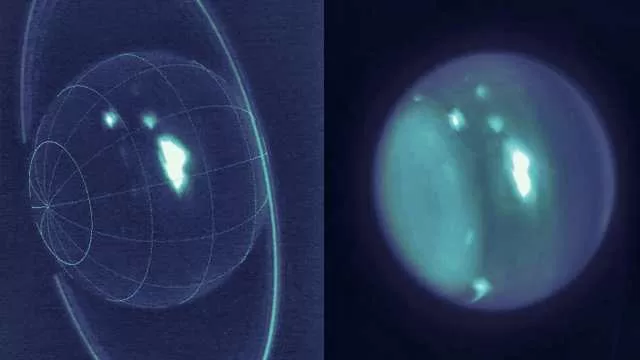Unraveling the Stormy Mysteries of Uranus
In a surprising turn of events, the usually tranquil atmosphere of Uranus has transformed into a tempestuous spectacle, captivating both professional and amateur astronomers alike.
For the first time, bright storm systems have emerged in the planet’s hazy blue-green atmosphere, allowing enthusiasts to observe details previously hidden from view.
A New Era of Observation
Imke de Pater, a professor of astronomy at the University of California, Berkeley, and her team were the first to detect this unusual activity using the W. M. Keck II Telescope in Hawaii. “The weather on Uranus is incredibly active,” de Pater remarked, noting that such phenomena were expected during the planet’s equinox in 2007 but had seemingly subsided since then. The recent resurgence of storms has left scientists puzzled, as they had anticipated a quieter atmosphere by now.
During observations on August 5 and 6, the team identified eight significant storms in Uranus’s northern hemisphere. One storm stood out as the brightest ever recorded at a wavelength of 2.2 microns, which detects clouds just below the tropopause. This storm accounted for an astonishing 30% of all light reflected by the planet at that wavelength.
Amateur Astronomers Join the Hunt
News of the stormy activity quickly spread, prompting amateur astronomers to turn their telescopes toward Uranus. French amateur astronomer Marc Delcroix was among those who successfully captured images of the bright storm. “I was thrilled to see such activity on Uranus,” Delcroix exclaimed, highlighting the excitement of observing details on Uranus and Neptune, which have long been considered the final frontiers for amateur astronomers.
Interestingly, the bright storm detected by the Keck Telescope was not the same feature observed by amateur astronomers. The amateur spot, identified by Delcroix and others, was found deeper in Uranus’s atmosphere, emitting light at a wavelength of 1.6 microns. This indicates that the amateur-detected feature lies beneath the uppermost cloud layer of methane ice, suggesting a connection to deeper atmospheric dynamics.
The Science Behind the Storms
Larry Sromovsky, a planetary scientist at the University of Wisconsin, Madison, explained that the amateur-detected storm may be linked to a vortex in Uranus’s deeper atmosphere, similar to the Great Red Spot on Jupiter. Such vortices can extend over large vertical distances, influencing the planet’s weather patterns.
In response to the amateur observations, an expanded team of astronomers led by Kunio M. Sayanagi from Hampton University proposed a “Target of Opportunity” observation with the Hubble Space Telescope. On October 14, HST captured images of Uranus, revealing multiple storm components stretching over 9,000 kilometers (5,760 miles) and clouds at various altitudes.
The Ice Giant’s Atmospheric Dynamics
Uranus, classified as an ice giant, is about four times the diameter of Earth and is primarily composed of hydrogen and helium, with traces of methane giving it its distinctive blue hue. Due to its great distance from the Sun—30 times farther than Earth—details on its surface have remained elusive until recent advancements in adaptive optics.
De Pater and her colleagues have been monitoring Uranus for over a decade, documenting its atmospheric phenomena, including swirling storms and convective features at its north pole. The bright clouds observed are likely formed by rising methane gases condensing into reflective ice clouds.
Despite the lack of an internal heat source, which was thought to limit atmospheric activity, the recent observations challenge previous assumptions. “These unexpected observations remind us keenly of how little we understand about atmospheric dynamics in outer planet atmospheres,” the researchers noted.
Conclusion
The recent storm activity on Uranus has opened a new chapter in planetary observation, inviting both professional and amateur astronomers to explore the mysteries of this distant ice giant. As scientists continue to study these phenomena, they are reminded of the complexities of atmospheric dynamics and the ever-evolving nature of our understanding of the universe. The excitement surrounding Uranus serves as a testament to the power of collaboration in the field of astronomy, where every observation—amateur or professional—contributes to our collective knowledge of the cosmos.

